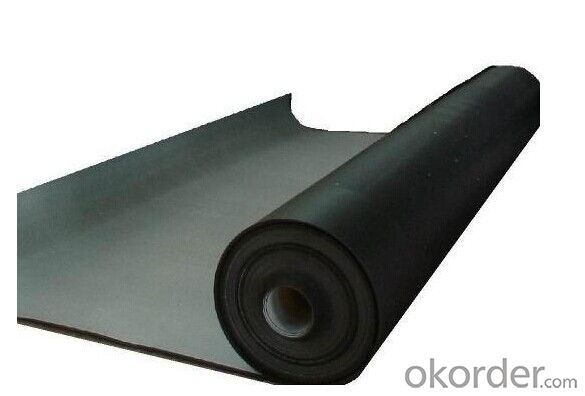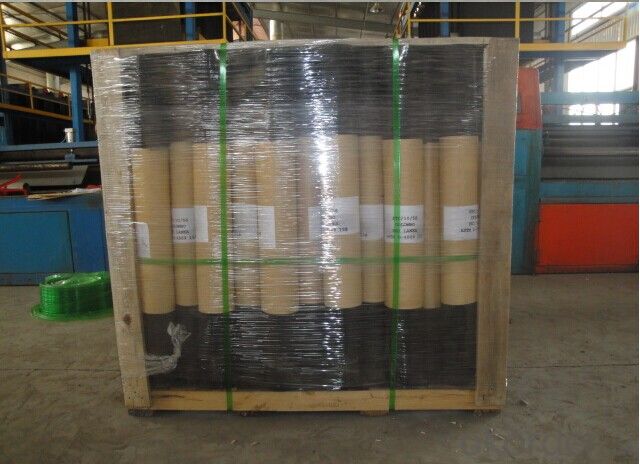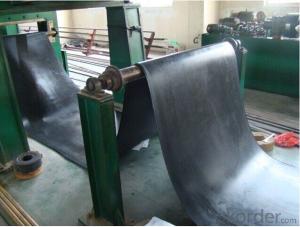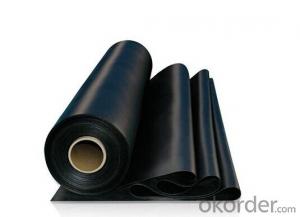EPDM Rubber Waterproof Membrane for Roof Use
- Loading Port:
- Qingdao
- Payment Terms:
- TT or LC
- Min Order Qty:
- 2000 m²
- Supply Capability:
- 300000 m²/month
OKorder Service Pledge
OKorder Financial Service
You Might Also Like
EPDM Waterproof Membrane
Product characteristics for EPDM Waterproof Membrane
1.Excellent anti-aging performance, service life can reach 50 years;
2.High elongation, high tensile strength, heat treatment size change small;
3.Plant root penetration resistance is good
4.Good low temperature flexibility
5.Application is convenient, overlapping is firm and reliable, no environmental pollution;
6. Resistance to chemical corrosion, can be applied to special places;
7.Maintenance is convenient, the cost is low
Uses for EPDM Waterproof Membrane
Widely used in roofs, basement, toilet ,swimming pool, and all kinds of industry and civil building waterproofing, reservoir, vivicism, bridge, underground, tunnel and dam waterproofing ,especially to the keystone waterproofing projects which is durability, high corrosion resistance and easy deformation
Specification for EPDM Waterproof Membrane
Item | Thick(mm) | Width | Length(m) | Color |
Spe | 1.0—2.0 | 1.2m/2m/3m/4m | 20 | Black |
Deviation | -1 +15 | --1 | Multicolor |
Technical Data for EPDM Waterproof Membrane
Item | value | ||
JL1 | JF1 | ||
Tensile Strength (Mpa) | normal tamperature | 7.5 | 4.0 |
60°C ≥ | 2.3 | 0.8 | |
Elongation at break (%) | normal tamperature ≥ | 450 | 450 |
-20°C ≥ | 200 | 200 | |
Tear Resistance (N) | ≥ | 25 | 18 |
Water impermeability | 30mm | 0.3Mpa | 0.3Mpa |
Cold bending | (°C) ≤ | -40 | -30 |
Heating Shrinking rate | extand << span=""> | 2 | 2 |
shrink << span=""> | 4 | 4 | |


FAQ:
Can you produce 4m width?
Yes, no problem for us. We have four bases in China, largest one in this field.
How many quantity in one 20'' container for 1.2mm and 1.5mm?
480rolls, 11520m2 for 1.2mm and 400rolls, 9600m2 for 1.5mm
Can you provide free samples?
Yes, our samples are free, but express fees usually on buyer's account.
- Q:Can a waterproofing membrane be used for loading docks?
- Yes, a waterproofing membrane can be used for loading docks. Waterproofing membranes are commonly used in construction and can provide a protective barrier against water intrusion, which can be beneficial for loading docks that may be exposed to rain, snow, or other forms of moisture. By applying a waterproofing membrane to the surface of the loading dock, it can help prevent water damage, deterioration, and potential safety hazards.
- Q:Can a waterproofing membrane be used on cinder block surfaces?
- Indeed, cinder block surfaces can benefit from the utilization of a waterproofing membrane. Given that cinder blocks possess porosity which allows water absorption, the application of a waterproofing membrane proves advantageous as it obstructs moisture infiltration and averts surface damage. In essence, this membrane functions as a protective barrier, shielding the cinder blocks against moisture-induced concerns like mold, mildew, and deterioration. To ensure optimal adhesion and efficacy, it is crucial to adequately prepare the cinder block surface prior to membrane application. Moreover, selecting a waterproofing membrane specifically tailored for cinder block surfaces yields the most satisfactory outcomes.
- Q:Can a waterproofing membrane be used on tunnels with railway systems?
- Yes, a waterproofing membrane can be used on tunnels with railway systems. Waterproofing membranes are commonly used in tunnel construction to prevent water ingress and protect the tunnel structure from deterioration. These membranes can effectively seal the tunnel walls, ceilings, and floors, preventing water from seeping into the tunnel and potentially causing damage to the railway system or infrastructure. Waterproofing membranes are specifically designed to withstand the high-pressure conditions and constant vibrations associated with railway operations. They are typically made of durable materials such as PVC, HDPE, or modified bitumen, which provide excellent waterproofing properties and long-term durability. Furthermore, these membranes can be installed during the construction phase of the tunnel or retrofitted onto existing tunnels with minimal disruption to the railway operations. Overall, the use of waterproofing membranes is a proven and effective method to ensure the structural integrity and longevity of tunnels with railway systems.
- Q:Can a waterproofing membrane be applied to any surface?
- A wide range of surfaces can typically have a waterproofing membrane applied to them, but there are factors that need to be taken into account. The suitability of the membrane depends on the specific type being used and the condition of the surface it will be applied to. Some membranes are designed to stick well to various surfaces such as concrete, masonry, metal, wood, and even certain plastics. These membranes have strong bonding capabilities and are formulated to provide excellent waterproofing protection. However, it is important to make sure that the surface is clean, dry, and free from any debris or contaminants before applying the membrane. Loose materials, grease, or oil can affect the adhesion and performance of the membrane. Furthermore, some surfaces may require additional preparation or priming before the membrane can be applied. For instance, highly porous surfaces like concrete might need a primer to improve adhesion. Similarly, surfaces with irregularities or cracks may need to be repaired or leveled before applying the membrane. In conclusion, although a waterproofing membrane can generally be applied to a variety of surfaces, it is crucial to consider the specific type of membrane and the condition of the surface. Proper surface preparation and adherence to the manufacturer's guidelines are vital for a successful and long-lasting waterproofing solution.
- Q:Can a waterproofing membrane be used on below-grade walls?
- Yes, a waterproofing membrane can be used on below-grade walls. In fact, it is highly recommended to use a waterproofing membrane on below-grade walls to protect them from water infiltration and moisture damage. Below-grade walls are particularly vulnerable to water penetration due to their proximity to the ground and potential for hydrostatic pressure. A waterproofing membrane acts as a barrier, preventing water from seeping into the walls and causing issues such as mold, mildew, rot, and structural damage. It helps to keep the interior of the building dry, preventing potential moisture-related problems.
- Q:Can a waterproofing membrane be used as a vapor barrier?
- Yes, a waterproofing membrane can also serve as a vapor barrier. Its primary function is to prevent the passage of water or moisture, which inherently includes the ability to block vapor transmission as well.
- Q:Can a waterproofing membrane be used on different types of surfaces, such as concrete, wood, or metal?
- Yes, a waterproofing membrane can be used on different types of surfaces such as concrete, wood, or metal. Waterproofing membranes are designed to create a barrier that prevents water from penetrating the surface and causing damage. They are versatile and can adhere to various materials, making them suitable for different applications. For concrete surfaces, a waterproofing membrane can be applied to protect against water intrusion and to prevent moisture-related issues such as cracks, corrosion, or mold growth. It can be used on concrete foundations, basements, or retaining walls to ensure they remain dry and structurally sound. When it comes to wood, a waterproofing membrane acts as a protective layer that prevents water absorption, warping, rotting, or decay. It can be applied to exterior surfaces like decks, balconies, or fences to enhance their lifespan and maintain their integrity. In the case of metal surfaces, a waterproofing membrane can be used to prevent rusting and corrosion caused by water exposure. It creates a barrier that seals out moisture, protecting metal roofs, gutters, or other metal structures from water damage. It is important to note that different types of waterproofing membranes may be more suitable for specific surfaces. For example, liquid-applied membranes can be easily applied on irregular surfaces like concrete, while sheet membranes may be more appropriate for flat or smooth surfaces. It is advisable to consult with a professional or manufacturer to determine the most suitable waterproofing membrane for a specific surface and application.
- Q:Can a waterproofing membrane be used in roofs?
- Roofs can indeed benefit from the use of a waterproofing membrane. It's a widely employed technique for safeguarding roofs against water-related harm. Typically composed of robust materials like rubber or modified bitumen, this membrane is applied to the roof's surface to establish a barrier that prevents water from seeping through. As a result, leaks and potential damage are averted, as this protective layer stops water from penetrating the roof's underlying structure. Waterproofing membranes are particularly advantageous for flat or low-sloped roofs, where water accumulation is prone to causing issues. Moreover, these versatile membranes can be utilized on diverse roofing materials, including concrete, metal, and asphalt, making them suitable for various roof types. Overall, incorporating a waterproofing membrane into roofs effectively enhances their durability and longevity, while ensuring dependable protection against water infiltration.
- Q:Can waterproofing membranes be used on elevator shafts?
- Yes, waterproofing membranes can be used on elevator shafts to prevent water infiltration and protect the structure from moisture damage.
- Q:Can a waterproofing membrane be used on brass surfaces?
- To safeguard surfaces from water infiltration and harm, one usually employs a waterproofing membrane. Despite brass surfaces not being particularly susceptible to water damage, an additional safeguarding layer can still be applied in the form of a waterproofing membrane. This can aid in the prevention of moisture accumulation on the brass surface, ultimately averting tarnishing or corrosion. Nonetheless, it is crucial to acknowledge that brass surfaces are often sought after for their innate patina and aesthetic allure. The application of a waterproofing membrane may alter the brass's appearance, potentially resulting in a glossy or artificial finish. Thus, it is prudent to thoroughly ponder the desired outcome prior to opting for the utilization of a waterproofing membrane on brass surfaces.
1. Manufacturer Overview |
|
|---|---|
| Location | |
| Year Established | |
| Annual Output Value | |
| Main Markets | |
| Company Certifications | |
2. Manufacturer Certificates |
|
|---|---|
| a) Certification Name | |
| Range | |
| Reference | |
| Validity Period | |
3. Manufacturer Capability |
|
|---|---|
| a)Trade Capacity | |
| Nearest Port | |
| Export Percentage | |
| No.of Employees in Trade Department | |
| Language Spoken: | |
| b)Factory Information | |
| Factory Size: | |
| No. of Production Lines | |
| Contract Manufacturing | |
| Product Price Range | |
Send your message to us
EPDM Rubber Waterproof Membrane for Roof Use
- Loading Port:
- Qingdao
- Payment Terms:
- TT or LC
- Min Order Qty:
- 2000 m²
- Supply Capability:
- 300000 m²/month
OKorder Service Pledge
OKorder Financial Service
Similar products
New products
Hot products
Hot Searches
Related keywords



























